In the ever-fluctuating world of finance, currency strength and weakness can pivot on the most surprising of developments, particularly statements from political leaders. The recent fluctuations of the US dollar and the euro serve as a case study in how economic perceptions can drive currency markets. This analysis will explore the underlying factors that contributed to these changes, evaluating President Trump’s remarks on interest rates and their implications for the economy and global trade.
On a particular Friday, the US dollar experienced significant weakening after President Donald Trump announced intentions to advocate for lower interest rates in a virtual address to the World Economic Forum. His assertion that “interest rates should drop immediately” sent ripples through the financial market, countering the dollar’s stability. Prior to this announcement, the currency had already experienced downward pressure, attributed largely to failed expectations surrounding tariffs that were anticipated to follow his inauguration.
Moreover, analysts at ING noted that Trump’s projected calls for reducing rates may not immediately affect Federal Open Market Committee (FOMC) meetings, suggesting the market may not respond drastically when rates are held steady. This hints at a more complex relationship between political announcements and market reactions, highlighting that while Trump’s rhetoric has often been geared toward protectionism, tangible results have not yet materialized. The market’s skepticism towards these protectionist promises has contributed to a growing narrative that the dollar may not enjoy the strength it once held.
While the US dollar faltered, the euro seized the opportunity to surge. Following the release of surprising economic activity data signaling growth in the Eurozone, the EUR/USD pair saw an increase of 0.8%. The HCOB’s preliminary composite Purchasing Managers’ Index (PMI) rose above the crucial 50 mark, indicating growth for the region, which has been plagued by economic uncertainty in recent months. Despite this positive news, it is essential to interpret the data with caution, as the manufacturing PMI remains in contraction territory.
European Central Bank (ECB) President Christine Lagarde’s impending address at Davos also coincided with shifts in the Eurozone’s economic outlook. Her previous comments on the necessity for gradual rate cuts drew attention to the ECB’s strategy amidst fluctuating confidence and external uncertainties. Even as the euro strengthened against the dollar, analysts remain wary of the ECB’s approach, asserting that while the immediate economic outlook appears to be stabilizing, deeper challenges may still lie ahead.
Across the English Channel, the British pound similarly benefited from favorable economic signals, rising 0.7% against the dollar after the UK PMI data showed improvement. The expansion indicated by the latest figures suggests a gradual recovery from previous economic hardships. However, optimism surrounding these numbers must be balanced with an understanding of the broader economic landscape, including the uncertainties stemming from post-Brexit implications.
The British economy’s ability to maintain a semblance of growth amidst external shocks underscores a resilience that is critical for investor confidence. As the PMIs suggest continued expansion in various sectors, the market is left to speculate whether this will materialize into sustained recovery or simply be a temporary uptick.
In Asia, currency movements reflected the shifts happening across the globe. The USD/JPY rate fell 0.5% as the Bank of Japan raised interest rates, showcasing the complexity of global interdependencies. Japan’s monetary policy indicates a commitment to combating inflation and maintaining economic stability, but the potential for further hikes contingent upon economic projections could introduce additional volatility into the market.
Similarly, the yuan appreciated against the dollar as foreign policy dialogues signaled a more conciliatory approach from Trump regarding trade. This responsiveness illustrates how American economic signals can ripple through Asian economies, further entrenching the notion that global markets are inherently interconnected.
The movements of the US dollar, euro, and British pound reveal a delicate balance influenced by political rhetoric and economic data. As President Trump continues to advocate for changes in monetary policy, and as central banks react to both internal and external pressures, the landscape of currency markets remains fluid. Understanding these dynamics is essential for investors seeking to navigate an increasingly complex global financial ecosystem.

